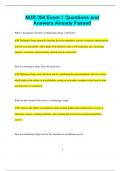NUR 354 Exam 1 Questions and
Answers Already Passed
What is the primary function of cholinergic drugs in the body?
✔✔Cholinergic drugs primarily stimulate the parasympathetic nervous system by enhancing the
activity of acetylcholine, which helps with functions such as lowering heart rate, increasing
digestive secretions, and promoting smooth muscle contraction.
How do cholinergic drugs affect the heart rate?
✔✔Cholinergic drugs lower the heart rate by stimulating the parasympathetic nervous system,
which leads to the release of acetylcholine, acting on muscarinic receptors in the heart to slow
down the rate of contraction.
What are the common side effects of cholinergic drugs?
✔✔Common side effects of cholinergic drugs include bradycardia, hypotension, excessive
salivation, nausea, vomiting, diarrhea, and sweating due to the increased parasympathetic
activity.
How are cholinergic drugs used in the treatment of myasthenia gravis?
1
,✔✔Cholinergic drugs, such as acetylcholinesterase inhibitors, are used to increase the levels of
acetylcholine at neuromuscular junctions, helping to improve muscle strength and reduce
symptoms of myasthenia gravis.
What is the mechanism of action of acetylcholinesterase inhibitors?
✔✔Acetylcholinesterase inhibitors work by blocking the enzyme acetylcholinesterase,
preventing the breakdown of acetylcholine and thereby increasing its concentration and activity
at cholinergic receptors.
What are the contraindications for using cholinergic drugs?
✔✔Cholinergic drugs should be used cautiously or avoided in patients with asthma, peptic ulcer
disease, bradycardia, or gastrointestinal obstructions, as these conditions may be exacerbated by
the increased parasympathetic activity.
What is the role of atropine in reversing cholinergic drug toxicity?
✔✔Atropine is an anticholinergic drug that can block the effects of excessive cholinergic
stimulation, such as bradycardia and excessive salivation, by inhibiting the action of
acetylcholine at muscarinic receptors.
2
,How does the drug physostigmine work in the treatment of poisoning from anticholinergic
drugs?
✔✔Physostigmine works by inhibiting acetylcholinesterase, which increases the levels of
acetylcholine and helps to counteract the toxic effects of anticholinergic drug poisoning.
What are some examples of cholinergic agonists and their clinical uses?
✔✔Examples of cholinergic agonists include bethanechol (used for urinary retention),
pilocarpine (used for glaucoma), and neostigmine (used for myasthenia gravis). These drugs help
stimulate cholinergic receptors and enhance parasympathetic responses.
What are the mechanisms by which drugs for seizures control seizure activity?
✔✔Drugs for seizures work by stabilizing neuronal membranes, reducing the excessive electrical
activity in the brain, and increasing the threshold for seizure activity. They can act by inhibiting
sodium or calcium channels or enhancing inhibitory neurotransmission (such as GABA).
What is the role of phenytoin in the management of seizures?
✔✔Phenytoin works by inhibiting sodium channels in neurons, which helps to prevent the rapid
firing of electrical impulses that can lead to a seizure.
3
, What are the common side effects of anticonvulsant drugs?
✔✔Common side effects of anticonvulsant drugs include dizziness, drowsiness, headache,
blurred vision, and gastrointestinal disturbances. Some medications may also cause gingival
hyperplasia (e.g., phenytoin) or skin rashes (e.g., lamotrigine).
How does carbamazepine work in the treatment of seizures?
✔✔Carbamazepine works by stabilizing the hyperexcitable state of neurons by inhibiting sodium
channels, which helps to prevent seizure activity. It is commonly used in the treatment of partial
and generalized seizures.
What are the risks associated with long-term use of anticonvulsant medications?
✔✔Long-term use of anticonvulsant medications can lead to cognitive impairments, bone
density loss, liver toxicity, and interactions with other medications, which may require ongoing
monitoring by healthcare providers.
How does valproic acid work to control seizures?
✔✔Valproic acid works by increasing the levels of GABA (an inhibitory neurotransmitter) in the
brain and inhibiting sodium and calcium channels, which helps to stabilize neuronal activity and
reduce the occurrence of seizures.
4




